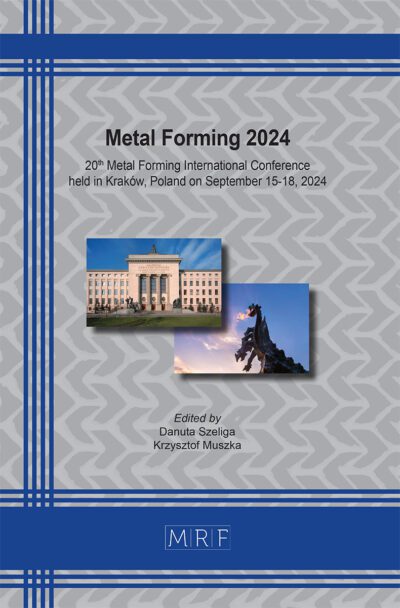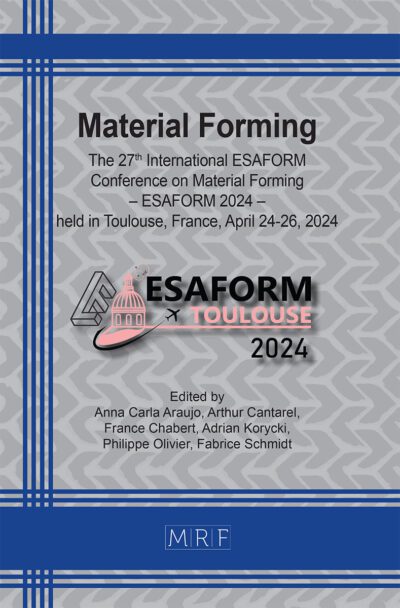Modeling the filament of magnesium alloys
Bruni Carlo
Abstract. The realization of the required geometry when representing the complex part of an object is determined by discretization of the material amount to be applied by a filament. The FDM of metals could in this way be competitive with conventional technologies to net shape making. The possibility to realize smaller and smaller filaments whose characteristics can be given in the extruding tool-material system by using proper geometries and parameters in order to produce the temperature rise inside the container is investigated. The analytical modeling proposed describes the extrusion behaviour of two magnesium alloys, that are the AZ31 and the ZM21 ones. That to perform a filament section of 0.4-0.5 mm in radius, beginning by a one of about 1.5 mm, with which to apply metal ribs. The effect of friction, distortion and heating phenomena as well as the solid fraction are considered on the stress vs. displacement curves inside the extruder until submillimeter diameter. The material model updated to consider the higher strain rates evidences the different behaviour of the models in describing different strain rates conditions useful to realize the filament geometry.
Keywords
FDM, Modeling, Magnesium Alloy
Published online 5/7/2025, 9 pages
Copyright © 2025 by the author(s)
Published under license by Materials Research Forum LLC., Millersville PA, USA
Citation: Bruni Carlo, Modeling the filament of magnesium alloys, Materials Research Proceedings, Vol. 54, pp 30-38, 2025
DOI: https://doi.org/10.21741/9781644903599-4
The article was published as article 4 of the book Material Forming
![]() Content from this work may be used under the terms of the Creative Commons Attribution 3.0 license. Any further distribution of this work must maintain attribution to the author(s) and the title of the work, journal citation and DOI.
Content from this work may be used under the terms of the Creative Commons Attribution 3.0 license. Any further distribution of this work must maintain attribution to the author(s) and the title of the work, journal citation and DOI.
References
[1] Alan A. Luo. Magnesium casting technology for structural applications. Journal of Magnesium and Alloys 1 (2013) 2-22. https://doi.org/10.1016/j.jma.2013.02.002
[2] T. Li, J. Song, A. Zhang, G. You, Y. Yang, B. Jiang, X.Y. Qin, C. Xu, F. Pan, Progress and prospects in Mg-alloy super-sized high pressure die casting for automotive structural components. Journal of Magnesium and Alloys 11 (2023) 4166-4180. https://doi.org/10.1016/j.jma.2023.11.003
[3] Q. Tang, M. Zhou, L. Fan, Y. Zhang, G. Quan, B. Liu, Constitutive behavior of AZ80 M magnesium alloy compressed at elevated temperature and containing a small fraction of liquid, Vacuum 155 (2018) 476-489. https://doi.org/10.1016/j.vacuum.2018.06.053
[4] W. Chen, W. He, B. Jiang, Q. Liu, F. Pan, Study on the compressive deformation behavior of a basal textured AZ31 magnesium alloy from the perspective of local strain, Materials Science & Engineering A 842 (2022) 143080. https://doi.org/10.1016/j.msea.2022.143080
[5] J. Chen, L. Rong, W. Wei, S. Wen, K. Gao, H. Huang, Z. Nie, An innovative thermal simulation study of microstructure improvement by delay forging during solidification, Journal of Materials Research and Technology 33 (2024) 4243-4252. https://doi.org/10.1016/j.jmrt.2024.10.122
[6] Huang, W., Chen, S., Xiao, J., Jiang, X., Jia, Y. Laser wire-feed metal additive manufacturing of the Al alloy. Opt. Laser Technol. (2021) 134, 10662. https://doi.org/10.1016/j.optlastec.2020.106627
[7] F. W. C. Farias, V. R. Duarte, I. Oliveira, J. da Cruz P. Filho, N. Schell, E. Maawad, J.A. Avila, J.Y. Li , Y. Zhang, G. Santos, J.P. Oliveira, In situ interlayer hot forging arc based directed energy deposition of Inconel® 625: process development and microstructure effects, Additive Manufacturing 66 (2023) 103476. https://doi.org/10.1016/j.addma.2023.103476
[8] L. E. S. Paes, H. Santos Ferreira, M. Pereira, F. A. Xavier, W. L. Weingaertner, L.O. Vilarinho, Modeling layer geometry in directed energy deposition with laser for additive manufacturing, Surface & Coatings Technology 409 (2021) 126-897. https://doi.org/10.1016/j.surfcoat.2021.126897
[9] A. I. Nurhudan, S. Supriadi, Y. Whulanza A. S. Saragih, Additive manufacturing of metallic based on extrusion process: A review. Journal of Manufacturing Processes 66 (2021) 228-237. https://doi.org/10.1016/j.jmapro.2021.04.018
[10] Y. Qi Li, F. Li, F. Wei Kang, H. Q. Du, Z. Y. Chen, Recent research and advances in extrusion forming of magnesium alloys: A review, Journal of Alloys and Compounds, 953 (2023) 170080. https://doi.org/10.1016/j.jallcom.2023.170080
[11] J. Feng, D. Zhang, H. Hu, Y. Zhao, X. Chen, B. Jiang, F. Pan, Improved microstructures of AZ31 magnesium alloy by semi-solid extrusion, Materials Science & Engineering A 800 (2021) 140204. https://doi.org/10.1016/j.msea.2020.140204
[12] M. Mousapour, M. Salmi, L. Klemettinen, J. Partanen, Feasibility study of producing multi-metal parts by Fused Filament Fabrication (FFF) technique, Journal of Manufacturing Processes 67 (2021) 438-446. https://doi.org/10.1016/j.jmapro.2021.05.021
[13] C. Bruni, Semisolid deposition of metallic material by extrusion-base analytical and simulative methodologies, Materials Research Proceedings 44 (2024) 433-44. https://doi.org/10.21741/9781644903254-47
[14] A. Jabbari and K. Abrinia, A metal additive manufacturing method: semi-solid metal extrusion and deposition, Int J Adv Manuf Technol (2018) 94:3819-3828. https://doi.org/10.1007/s00170-017-1058-7
[15] K. Andersen, Y. Dong and W. S. Kim, Highly conductive three-dimensional printing with low-melting metal alloy filament, Advanced engineering materials 19 (2017) 1700301. https://doi.org/10.1002/adem.201700301
[16] P. P. Selvam, S. Prabhakaran , B. Vinod , T. Jishnu. A review of energy efficiency and Machine learning analysis for additive manufacturing of direct laser metal deposition Materials Today: Proceedings.
[17] E. Navaneetha , A. A. Lakshmi, Cold extrusion on bulk materials: A review. Materials Today: Proceeding.
[18] C. O. Ufodike, G. C. Nzebuka. Investigation of thermal evolution and fluid flow in the hot-end of a material extrusion 3D Printer using melting model. Additive Manufacturing 49 (2022) 102502. https://doi.org/10.1016/j.addma.2021.102502
[19] C. Bruni, M. El Mehtedi, and F. Gabrielli, Flow curve modelling of a ZM21 magnesium alloy and finite element simulation in hot deformation, Key Engineering Materials Vols. 622-623 (2014) 588-595. https://doi.org/10.4028/www.scientific.net/KEM.622-623.588
[20] C. Bruni et al., Constitutive models for AZ31 Magnesium alloys, Key Engineering Materials, 367 (2008) 87-94. https://doi.org/10.4028/www.scientific.net/KEM.367.87
[21] C.L. Liu, X. Wang, N.C. Parson, W.J. Poole, The effect of Mn on the high temperature flow stress of Al-Mg-Si alloys, Materials Science & Engineering A 802 (2021) 140605. https://doi.org/10.1016/j.msea.2020.140605
[22] F. Zhang, Z. Liu, M. Yang, G. Su, R. Zhao, P. Mao, F. Wang, S. Sun, Microscopic mechanism exploration and constitutive equation construction for compression characteristics of AZ31-TD magnesium alloy at high strain rate, Materials Science and Engineering: A, 13 2020, 138571. https://doi.org/10.1016/j.msea.2019.138571
[23] X. Liu, B.W. Zhu, C. Xie, J. Zhang, C.P. Tang, Y.Q. Chen. Twinning, dynamic recrystallization, and crack in AZ31 magnesium alloy during high strain rate plane strain compression across a wide temperature. Materials Science & Engineering A 733 (2018) 98-107. https://doi.org/10.1016/j.msea.2018.07.030
[24] E.Kahana,A.B.-Artzy, O.Sadot, R.Z.Shneck, Microstructural evolution of AZ31 magnesium alloy after high strain rate expanding rings tests, Materials Science&Engineering A641 (2015) 274-280. https://doi.org/10.1016/j.msea.2015.06.054













